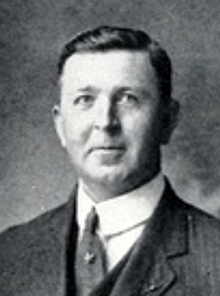
Charles A. Keith
On Jan. 10, 1910, President Oliver Burnside Andrews announced that every Southern League game for the upcoming season would be played at Andrews Field with only an occasional exhibition game “coming off” at Chamberlain Field. Andrews Field was now the official home of the Champs of Dixie.
One month later, on Sunday, Feb. 13, a large group of baseball fans visited the field accompanied by a Chattanooga News reporter. It was a cold, blustery day and the snow and ice crunched underfoot as they examined their surroundings. “Those who saw Andrews Field for the first time yesterday were surprised at the magnitude of work which has been accomplished in a short time. The large grandstand and bleachers are practically ready for their occupants.” In the group’s opinion only Ponce de Leon Park in Atlanta could compare but even that park had “not a shade of advantage over” Andrews Field. As they noted, the grandstand and bleachers had been designed to afford protection from the “burning rays of a summer sun” and, since the larger bleacher stand faces east, the sun will be at the back of most fans. A separate set of bleachers for Negro sports were being constructed along the left field line.
The field’s designers were forward-thinking and created an abundance of space at the south end of the field for auto and carriage parking. Drivers would enter from O’Neill Street, immediately to the west, and an entrance had been graded at the southwest corner of the field.
The Andrews Field Clubhouse boasted every comfort a hometown or visiting player might require. Johnny Dobbs, manager, remarked that Chattanooga’s structure would be “somewhat of an innovation, as some of the Southern League clubhouse accommodations are very modest indeed.”
And, the press box!! A section of the grandstand immediately behind Homeplate has been set aside as the press box, with ample space for both newspaper men and telegraph operators who will cover each game. Since the majority of the visiting teams will bring their own reporters and several wire services, the press box at Andrews had almost double the space available at the Chamberlain Field facility.
Andrews and Dobbs expected that ‘play’ at Chattanooga’s field will stretch the competitors since they believed only “a few balls will be hit over the fences.” The left field fence, nearest the batter’s box, is fifteen feet further from the plate than the Chamberlain fence. Local merchants were already vying to the right to have “signs upon its surface announcing that the player who can drive the sphere over the fence will be furnished with sundry articles of wearing apparel free of cost.” According to Dobbs, any balls that flew beyond the fence would be a legitimate “homer” on any major league grounds. And, the field itself, a turtle-back diamond, sloped beautifully so that the surface will drain quickly.
Opening day for the field was scheduled for April 11, 1910, when Pittsburg would play a two-game exhibition series with the first real workout for the Chattanooga team set for March 8. The first workout would focus on the “four twirlers” – – the team’s potential pitchers – – Hart, Buchanan, Fulenwider and Rhodes. The final candidate and the strongest prospect for starter, Charles A. Keith, was not expected until April since he was coaching the University of Texas baseball team.
Keith was an unusual star; the 6’6” pitcher had been with Little Rock for several seasons and accumulated an outstanding record. A self-described “educational tramp” since he was always taking classes at different universities, the Arkansas native took off a year from the St. Louis Americans after receiving a Rhodes scholarship, traveling to Oxford University to earn a degree in Political Philosophy. [He remains the only person ever to hold a big-league baseball contract and a Rhodes scholarship simultaneously.]
Andrews invited fans to visit “Mecca” to watch practice sessions while looking the players over. He laughed as he commented that the “dyed-in-the-wool fan has as about a critical eye for a ball player as a horse trader has for horse flesh.” Additionally, there would be opportunities at the Russell House, training headquarters, for evening discussions. Andrews understood that creating an enthusiastic fan base was a major factor in the success of any franchise.
Chattanooga was well on its way to establishing Andrews Field as the city’s baseball home.
____
Linda Moss Mines is the official Chattanooga and Hamilton County historian.
This article was originally published by a www.chattanoogan.com . Read the Original article here. .

